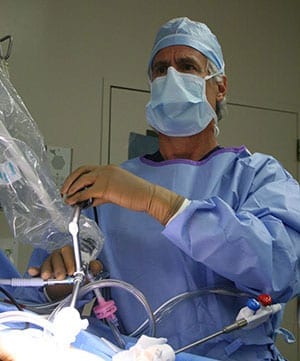Endometriosis is diagnosed during a diagnostic laparoscopy, in which areas of disease are visualized and biopsies are obtained.
-Dr. Cook

The gold standard for the diagnosis of endometriosis is diagnostic laparoscopy, Band-Aid surgery under general anesthesia in which the surgeon inspects the inside of the patient’s pelvis with a special fiber optic camera. During this procedure any areas of abnormal tissue are identified, biopsies are taken and, if applicable, a diagnosis of endometriosis is later confirmed via microscopic examination of the biopsied areas of tissue by a pathologist.
While endometriosis may be suspected based on pelvic exam, medical history and imaging studies (MRI, CT, and Ultrasound), diagnostic laparoscopy is the only way of diagnosing the disease. [1]
If Dr. Cook suspects you may have endometriosis, he may well recommend that the diagnosis be confirmed during a diagnostic laparoscopy. If abnormal tissue is visualized during this procedure he will then carefully remove all areas of disease at the same time via surgical excision.
While there are non-invasive treatments for endometriosis, such as medical therapies, these treatments treat the symptoms and not the disease. The only treatment that both confirms the diagnosis and actually removes the disease is surgery. Undergoing laparoscopic diagnosis and treatment of endometriosis is, therefore, the cornerstone of the comprehensive multidisciplinary care offered to patients who come to us for the treatment of suspected endometriosis.
The surgical experience itself was better than I’d ever had. Dr. Cook made sure that I was warm, relaxed and not nauseated (the part of anesthesia I dread). I am less than a month out from surgery but I feel good knowing that Dr. Cook and his team are still invested in my recovery. They will continue to track & help my progress for the next year.
-Diana
Will a diagnostic laparoscopy provide me with answers?
It takes a trained eye to identify all areas of disease and not to overlook subtle forms of endometriosis, which can lead to false negatives (failure to diagnose the disease even though disease is present). With Dr. Cook’s wealth of expertise in identifying even the subtlest forms of this disease you can be confident that if endometriosis is a factor in your pain, he will find it and meticulously treat it during laparoscopy.
Due to his clinical experience, if Dr. Cook suspects endometriosis based on your medical history and pelvic exam, in the vast majority of cases this diagnosis will indeed be confirmed during diagnostic laparoscopy.
Notes
1. Occasionally a patient will have endometriosis that has invaded from the pelvis into the vagina or will have cutaneous endometriosis (endometriosis involving a surgical scar). In these unusual cases, biopsies may be obtained without the need for diagnostic laparoscopy, although surgery will be needed for the complete removal of the disease.
